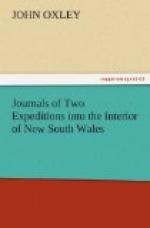Although the present pass is the only practicable point yet discovered for descending by, yet the mountain is much higher than those on either side of it, from whence it is distinguished at a considerable distance: when approaching it from the interior, and in this point of view, it has the appearance of a very high distinct hill, although it is in fact only the abrupt termination of a ridge. The governor gave the name of Mount York to this termination of the ridge: on descending Cox’s Pass, the governor was much pleased by the appearance of good pasture land, and soil fit for cultivation, which was the first he had met with since the commencement of his tour. The valley at the base of Mount York he called the Vale of Clwyd, in consequence of the strong resemblance it bore to the vale of that name in North Wales: the grass in this vale is of a good quality, and very abundant; and a rivulet of fine water runs along it from the eastward, which unites itself at the western extremity of the vale with another rivulet, containing still more water. The junction of these two streams forms a very fine river, now called by the governor Cox’s River; which takes its course, as has since been re-ascertained, through the Prince Regent’s Glen, and empties itself into the River Nepean; and it is conjectured from the nature of the country through which it passes, that it must be one of the principal causes of the floods which have been occasionally felt on the low banks of the River Hawkesbury, into which the Nepean discharges itself. The Vale of Clwyd from the base of Mount York, extends six miles in a westerly direction, and has its termination at Cox’s River. Westward of this river the country again becomes hilly, but is generally open, forest land, and very good pasturage. Three miles to the westward of the Vale of Clwyd, Messrs. Blaxland, Wentworth, and Lawson, had formerly terminated their excursion; and when the various difficulties are considered which they had to contend with, especially until they




